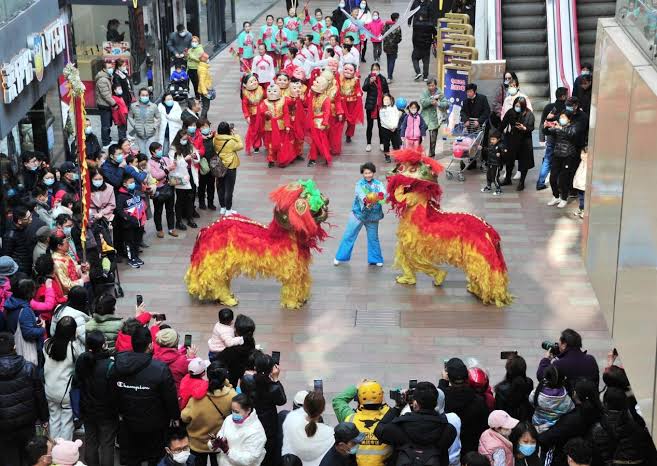By making products, services, business forms, as well as other elements of their supply structure more flexible and adaptable to new changes in consumer demands, many brick-and-mortar stores in China have managed to win favor with consumers again.
In the consumer market, physical retailers serve as an important foundation for the circulation of commodities, an important carrier for guiding production and expanding consumption as well as a critical channel for vitalizing the market and ensuring employment.
Chengdu International Finance Square (Chengdu IFS), an international urban complex in southwest China’s Sichuan province, provides consumers with diversified shopping experiences.
“Even if I didn’t want to buy anything, it would still be fun to look around in the mall,” said a citizen.
The Chengdu IFS boasts business forms covering almost all aspects of life, such as catering, leisure, entertainment and fitness, with the types of stores ranging from bookstore to musical instrument shop, tea house, flower shop, beauty salon, and fitness center.
A food court in the sky garden on the top floor of the mall is particularly popular among foodies because of its pleasant environment.
At a shopping mall of Jinan Inzone Plaza at Quancheng Square, Jinan, east China’s Shandong province, a redecorated supermarket is crowded with consumers. The upgraded supermarket has adjusted its commodity structure according to consumer demands.
For instance, its livestock and aquatic products zone highlights the theme of fresh and healthy food. By demonstrating the processing of food, the supermarket offers consumers a special shopping experience during which they can get a clear idea of the appearance, smell, taste, and form of the products.
In addition, more than 1,000 kinds of goods directly imported by the supermarket from abroad have been added to the shelves. “These imported goods with distinctive characteristics sell very well,” said a manager at the supermarket.
“I took my child here for its naked-eye 3D screen. It makes me feel like I’m in a science fiction world,” said a consumer, referring to JD Mall, a physical shopping center built by Chinese e-commerce giant JD.com. Trendy and sci-tech elements have been widely integrated into the overall design and interactive devices of the shopping center, which is now gaining increasing popularity among local citizens and on the Internet.
Its exterior features a large naked-eye 3D screen, which produces so vivid 3D effects that things displayed on the screen seem touchable. The inside of the shopping center is equipped with various refreshing sci-tech devices and facilities, including hologram projector, virtual reality (VR) equipment, intelligent robot, virtual livestreaming studio and machine room with transparent circuits.
Innovation is the direct driving force for the transformation of brick-and-mortar stores, according to Zhao Ping, deputy head with the Academy of China Council for the Promotion of International Trade.
In recent years, physical retail in China, while growing in size, has vigorously cultivated new business forms and models by strengthening the application of new-generation information technology concerning such fields as the Internet and big data, not only further improving efficiency in the circulation of goods and the level of services, but providing consumers with more new supplies and winning their hearts once again, Zhao noted.
“Compared with online shopping, physical stores have their unique advantages. As long as they can offer high-quality products and services, they will certainly attract customers,” said an executive of Jinan Inzone Plaza.
The executive believes that brick-and-mortar stores can truly become appealing by responding to the ever-escalating demands of consumers and satisfying young people’s demands for drinking coffee and meeting friends.
Turning offline shopping into a lifestyle becomes many physical stores’ magic key to greater customer stickiness. Many retail outlets have put a lot of effort into improving shoppers’ experience, successfully combining shopping and entertainment functions.
“When I shopped for clothes in the mall, I always worried about how to match clothes. Now with the suggestions from fashion stylists working here, I feel much easier,” said Zhang Wei, a citizen in Hangzhou, east China’s Zhejiang province. She recently purchased two outfits efficiently at Chinese retail conglomerate Yintai Group’s shopping mall at Wulin Square in the city, with the help of the mall’s stylists.
In response to the needs of some consumers, the shopping mall introduced styling services two years ago, which have been well received by customers, said an executive at the mall.
While developing unique curriculum to unleash the professional capabilities of shop assistants, the mall has given full play to new retailing so that customers can seek advice on styling online and make reservations online for offline styling services.
Transformation is an inevitable path for traditional shopping centers, the key of which lies in catering to consumption trends while taking into account their own locations and characteristics and ensuring scientific and rational planning and management for transformation, according to Peng Long, professor as well as executive vice president of the Southwestern University of Finance and Economics.


